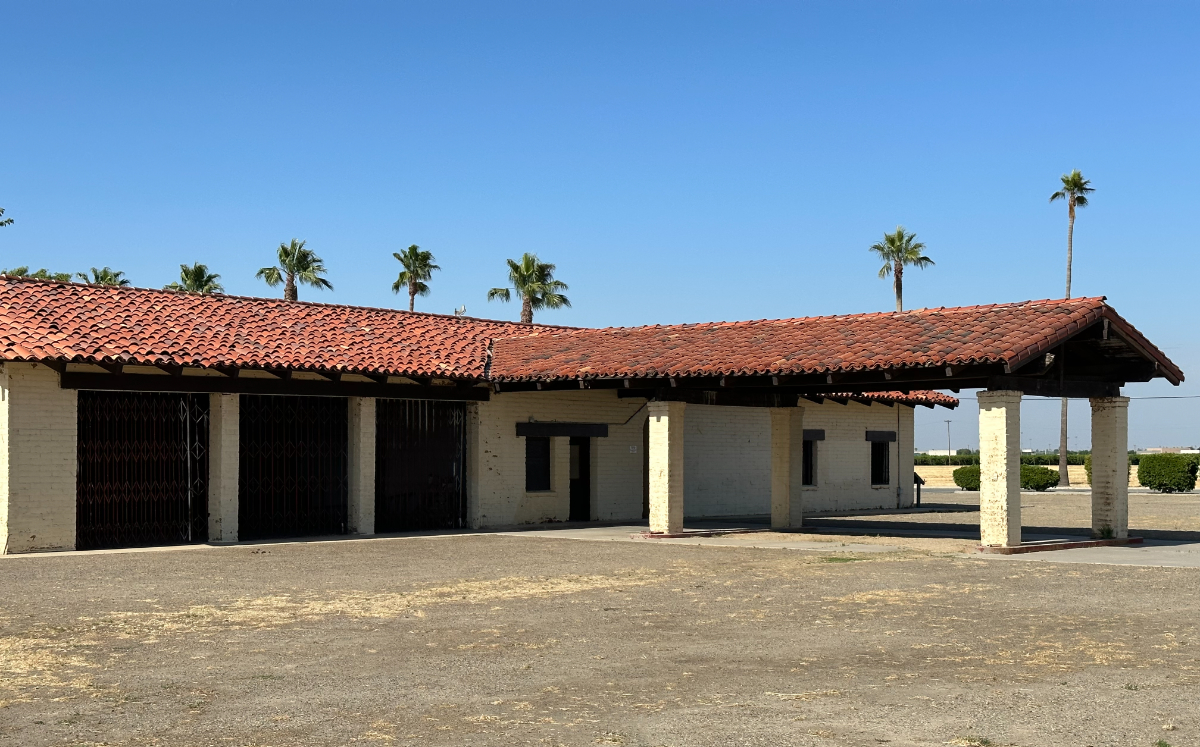Why does the United States set aside certain places for preservation, maintenance, and public use?
Originally published on Global Voices

The Forty Acres, the first headquarters of the United Farm Workers labor union, in Delano, California. Photo by Ivan Sigal (CC BY 4.0)
This article is part of a series by J. Nathan Matias for a 500+ mile bicycle ride in June 2023 that is raising funds for Rising Voices, Global Voices’ endangered/Indigenous language program, and the Central California Environmental Justice Network. Donate to the initiative here.
Before Mariah Lopez and Daniella Mosqueda graduated from high school in Delano, California, they knew where they wanted to take their graduation photos: The Forty Acres, the former home of the United Farm Workers. The mission-style service station surrounded by beautiful tall trees makes a great backdrop for photos. But The Forty Acres is also significant for another reason: the 25-day hunger strike by labor activist Cesar Chavez that captivated the world in 1967.
Who goes for graduation pictures at the site of a hunger strike? The sight of Daniella, Mariah, and their families stepping out of their cars in their graduation caps and gowns completely transformed my understanding of a site I had only seen in history books. They also helped us see why the U.S. government is considering incorporating The Forty Acres into a proposed National Park.

(L to R) Ivan Sigal, Elisa Lopez, Mariah Lopez, Danielle Mosqueda, and J. Nathan Matias outside The Forty Acres. Photo courtesy the Lopez family
When Mariah and Daniella arrived Ivan Sigal and I had just leaned our bikes against the station’s brick walls, 70 miles into a 550-plus mile bicycle journey through California’s Central Valley. Ivan and I are tracing the route of the 1966 Farmworkers March and telling stories about the people we meet. We rolled into Delano at the end of our first day in search of a legend enshrined in the media, feature films, and the world’s imagination.
The story of Forty Acres is the second chapter to the famous Farmworkers March of 1966. When nearly a hundred farm workers and union organizers set out on foot for Sacramento— California’s state capital—that year, they were trying to seek influence by creating a legend. Influenced by Mahatma Gandhi and Martin Luther King Jr., they hoped to inspire Filipino and Latino workers to join together and build public support for those workers throughout the valley.
Their plan worked. By the time they reached Sacramento the farmworkers had elevated “La Causa” to international attention, developed powerful alliances with national politicians, and negotiated their first union contracts.

Ivan Sigal's and Nathan Matias’ bicycles leaning against the wall of the service station at The Forty Acres. Photo by Ivan Sigal (CC BY 4.0)
But what does a movement look like when it’s not on the move? That’s the question that motivated the United Farm Workers to purchase The Forty Acres later that year, quite literally as a cooperative service station for the community. Volunteers built the station to serve as a stopover point for fuel, repairs, and community services. Revenue from gasoline sales would be used to compensate families on strike who needed critical supplies. Later on, they added a retirement home for Filipino workers whose landlords had evicted them for joining the strike.
By 1968, Chavez had become concerned that some in the movement were considering responding to violence from farm owners and police with sabotage and violence. Inspired by Gandhi, in February 1968 he announced he was going on a water-only fast, calling for nonviolent methods and demanding that grape growers negotiate with union leaders over wages. Twenty-five days later, the US presidential candidate Robert F. Kennedy convinced Chavez to relent, and in a highly visible media event, was photographed handing him a piece of bread (the iconic incident is depicted in the movie trailer below). Within a year, Cesar Chavez was on the cover of TIME Magazine as “Person of the Year.” Within another year, grape growers had negotiated union contracts with workers.
As an outsider to Delano, I only knew the legend and the critiques of Chavez as a celebrity leader. I also arrived in the Central Valley asking questions about the idea of memorializing a movement whose work is far from compete. But I had forgotten other important reasons that the United States. creates national parks.
Why does the U.S. set aside certain places for preservation, maintenance, and public use? We came to the Central Valley with the mindset of Freeman Tilden, who argued that parks provoke us to re-imagine our assumptions by putting us in contact with significant places. The symbolic power of these sites also lends weight to important civic moments like First Lady Jill Biden’s visit to The Forty Acres at the height of the COVID-19 pandemic.

The service station at The Forty Acres. Photo by Ivan Sigal (CC BY 4.0)
But parks also serve a deeper purpose. According to the environmental philosopher John Muir, parks are places where play and prayer can “heal and cheer and give strength to the body and soul alike.”
Since our visit to The Forty Acres, I’ve come to understand national parks as places where we make meaning and create new stories across the generations, not just search for the past. Yes, this historical site does provoke us to think about labor, nonviolence, and the complicated power of celebrity. But on this Tuesday evening in early June, this hand-built brick service station was also the place where two young women whose remarkable stories have yet to unfold, chose to mark the start of the next step in their journey.
Read more background about the ride, including its goals and Nathan and Ivan's itinerary, at our special coverage page.
Post a Comment